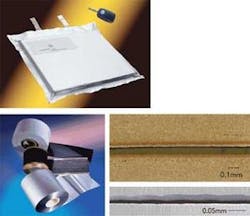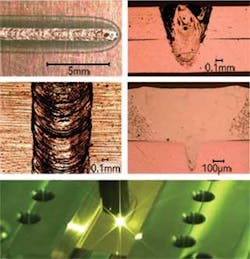Laser processing enables advanced batteries that will power future hybrid electric vehicles
by Hans J. Herfurth
The looming energy crisis and global environmental concerns have been attracting significant attention worldwide. The continued reliance of automobiles on fossil fuels, which consume almost 45% of all fossil fuels produced, is one of the primary causes of global warming.1 Reducing the demand for foreign oil has been widely recognized as a faster, cleaner, and cheaper path to energy security.
FIGURE 1. Schematic of lithium-ion cell
Recently, battery-based hybridization of gasoline and diesel engines has become a rapidly expanding global market, because it combines the benefits of high fuel economy and low emissions with the power, range, and convenience of traditional gasoline and diesel powered vehicles. According to a report by The Boston Consulting Group,2 an estimated 14 million electric and hybrid cars may be sold in 2020 in the world's four largest automotive markets—Western Europe, North America, Japan, and China—up from some 480,000 in 2008.
A variety of systems such as hybrid electric vehicles (HEV), plug-in hybrid electric vehicles (PHEV), and electric vehicles (EV) are either on the market or currently under development. In today's HEVs, such as the Toyota Prius, the electric motor primarily assists in the acceleration of the vehicle in stop-and-go traffic while it is powered by its gasoline engine most of the time. Due to a small battery the range in electric mode is limited. In contrast, a PHEV has a more powerful battery pack providing an extended range reaching into the ten's of miles and it can also be recharged from grid. EVs can be solely operated as an electric, emission-free vehicle.3 Their battery pack can be recharged from the grid or via a small gasoline engine on board. The range is expected to be approximately 40 miles on a single charge covering most if not all of the daily commute for many consumers. The new Federal government administration has set a target of 1 million electric cars on U.S. roads by 2012. This would represent an estimated market volume of $40 billion for advanced batteries.4
One enabling factor for the development of new hybrid systems for vehicles is significant advancements in battery technology.5 Today, Nickel-Metal-Hydride (NiMH) batteries are used in HEVs offering higher capacity compared to conventional lead acid or NiCd cells. Future PHEVs will require even lighter, more compact, and higher-capacity batteries to achieve the targeted driving range. Battery manufacturers are expected to share some of the $25 billion set aside last year under the government's Advanced Technology Vehicle Manufacturing Program to speed the commercialization of such technology.4 Most developers believe that the lithium-ion batteries can address these challenges as they can store up to three times more energy, generate twice the power, and can store twice as much energy per liter of volume compared to NiMH batteries used today.3 According to a report by Fuji Keizai Co., the market for lithium-ion battery materials will increase to US$6.9 billion in 2012, an 89% increase from 2007.6 For example, the T-shaped lithium-ion battery pack for the Chevrolet Volt, to be marketed in late 2010, will contain approximately 220 cells.4 In addition to reliability and safety,7 battery cost will play an important factor for a broad market acceptance of PHEVs utilizing lithium-ion technology. In addition to material cost, battery pricing will be significantly impacted by the manufacturing cost in mass production.
FIGURE 2. Lithium-Polymer Battery (Fraunhofer ISIT) and (a) electrodes for Lithium-Ion batteries (Fraunhofer-ISIT) and (b) top view of a laser cut copper foil sample taken with optical microscope and (c) with SEM. The gap shown does not represent the cut kerf because the sample is completely separated.
Mass production with lasers
Dissimilar material joining, hermetic sealing, localized processing, high precision, consistent quality, and high throughput are key factors for efficient battery manufacturing. Advanced laser systems combined with innovative processing technology can provide cost effective solutions for a variety of applications in mass production of lithium-ion batteries. FIGURE 1 shows the basic elements of a cylindrical battery cell. The electrode package consists of coated metal foils that are wound to a roll. This electrode package is hermetically sealed in a metal can and electrically connected to the outside terminals. Cells with planar shape (see FIGURE 2) and stacked electrodes or prismatic cells represent alternate designs for lithium-ion batteries currently being pursued.
A variety of cutting, joining, and sealing operations are required for the production of electrodes and the assembly of cells and modules. Potential laser applications include: electrode cutting, joining of internal components to the electrodes and the terminals, and sealing of the battery housing. Most metal components are made of copper or aluminum because of their superior electrical properties. The high reflectivity of these materials, which has posed a challenge for laser processing in the past, can now be successfully addressed by state-of-the-art high brightness lasers, which also enable the joining of these materials in similar and dissimilar configurations.
Electrode cutting
Lithium-ion battery electrodes are made from active material coated on both sides of aluminum and copper foils that serve as current collectors. Foil thicknesses range from 0.01 mm (uncoated) to 0.2 mm (coated) depending on the cell design (cylindrical or planar) and the electrode type (cathode or anode). Die cutting is used to stamp planar electrodes and rotary knife slitting is applied to cut electrode strips for cylindrical cells. Both techniques require relatively expensive tooling that wears over time resulting in process instabilities and poor cut quality. Specifically, slight bending of the cut edge and the formation of micron sized material attachments can result in short circuits and catastrophic failure of the complete system. Therefore, frequent maintenance and tool replacement is required.
Laser cutting of electrode materials has been investigated to establish feasibility at high speeds and to determine cut quality and potential cost benefits compared to mechanical slitting. Disk and fiber lasers provide the high beam quality necessary to achieve the small spot sizes and high intensity levels required to cut the highly reflective copper and aluminum foils. Process optimization and acceptable cut quality were achieved using single mode fiber lasers. Cutting speeds of more than 10 m/min require relatively low power in the range of 50W to 200W. The ongoing work shows that contact-free laser cutting has the potential to become a serious competitor to conventional cutting processes offering no tool wear, high flexibility, and consistent cut quality.
Battery assembly
Most current carrying components inside a lithium-ion battery are made of copper or aluminum as are the external buss bars that must be joined to the outside terminals to connect a series of cells. A very reliable joining process must be applied to connect the internal parts and to seal the battery housing because of the expected 8–10 years life cycle for HEVs. Joining of metals in similar and dissimilar configurations is required to establish electrical contact to the outside terminals as the connections must provide good conductivity to avoid power losses. Overlap joints are preferred because they are less demanding regarding part tolerances and fit-up. Typically, aluminum cans are used as housings for cylindrical cells that require hermetic sealing as one of the final critical steps in the cell assembly.
Laser welding of highly reflective copper is more demanding on the laser source and on the process design because the highly non-linear laser beam-material interaction yields to narrow process windows and limited repeatability. Nickel plating or placements of nickel sheet on top of the copper are methods currently used to enhance the absorption and improve the process stability in copper welding. Fraunhofer CLT has investigated both continuous and pulsed laser welding processes for different battery assembly applications using Nd:YAG, disk, and fiber lasers in the 500W to multi-kilowatt power range (see FIGURE 3). These laser sources provide the needed intensity to establish the keyhole welding process and enable high welding speeds and short cycle times that are required for cost effective mass production.
FIGURE 3. (a) Weld surface and (b) a cross section of a full penetration overlap weld of two 0.5mm thick copper sheets (alloy 110) at 5m/min using power of 2.1kW. (c) Weld surface and (d) a cross section of an aluminum (alloy 3003, thickness: 0.55mm) to copper (alloy110, thickness: 0.6mm) weld at 1m/min using only 470W, and (e) laser welding of copper using high brightness fiber coupled diode laser developed by Fraunhofer CLT.
In addition, the effectiveness of alternative surface treatments and coatings was evaluated. Considerable improvements in process stability, welding speed, and penetration depth are observed if a thin graphite coating is applied. The process is almost spatter-free and the weld appearance is very consistent. Recent advancements in high brightness fiber-coupled diode lasers developed at Fraunhofer CLT lead to successful welding of bare copper sheet (0.2 mm thickness) at 1 m/min using power of only 250W.
New laser welding processes are also developed for dissimilar joining of aluminum to copper and copper to aluminum. The optimized process design minimizes the formation and growth of various intermetallic phases that otherwise lead to an embrittlement of the weld that can result in micro and macro cracks as both metals have very low metallurgical affinity.
Pulsed Nd:YAG laser welding can be applied to spot weld copper to aluminum in an edge weld configuration. Successful welding of aluminum to copper in an overlap configuration is achieved with a single mode fiber laser. Due to the differences in material properties the size of fusion zone changes significantly at the interface. Only the core of the laser beam penetrates into the copper. Nevertheless, the joints show excellent strength and durability, proven in lap shear strength and fatigue testing. Test coupons exceeded 1 million load cycles for loads up to 60% of the ultimate shear strength (USS).
Conclusion
The results presented for various applications in the manufacture and assembly of advanced batteries demonstrate that high-speed laser processing can provide effective solutions to reduce manufacturing costs, which is key to consumer acceptance of the new technology.
References
- International Conference on Advanced Lithium Batteries for Automobile Applications, Argonne, IL September 15-17, 2008.
- “The comeback of the electric car? How real, how soon, and what must happen next,” Boston Consulting group report, January 2009.
- J. Muller and A. Stone, “Jump Start,” Forbes, April 2008.
- P. Engardio, “The electric car battery war,” Business Week, February 2009.
- M. Alamgir, and A.M. Sastry, “Efficient Batteries for Transportation Applications,” SAE Convergence, Detroit, MI, October 2008.
- http://www.greencarcongress.com/2009/01/report-lithium.html
- J. McDowall, “Understanding Lithium-Ion Technology,” Battcon, Marco Island, FL, April 2008.
- H.J. Herfurth, R. Patwa, H. Pantsar, S. Heinemann, and G. Newaz, “Laser processing for alternative energy devices: Advanced battery and fuel cell applications,” ICALEO, Temecula, CA, October 2008.
Hans J. Herfurth ([email protected]) is deputy director at the Fraunhofer Center for Laser Technology, Plymouth, MI.; www.clt.fraunhofer.com


